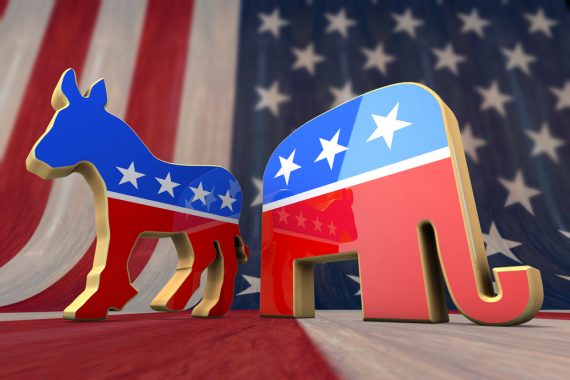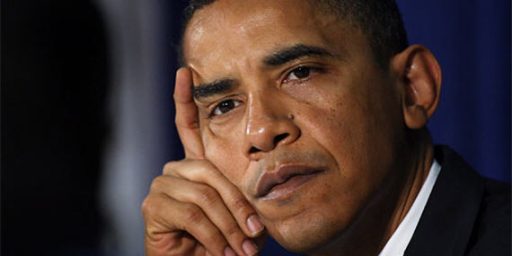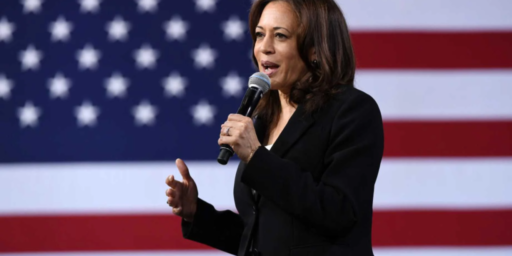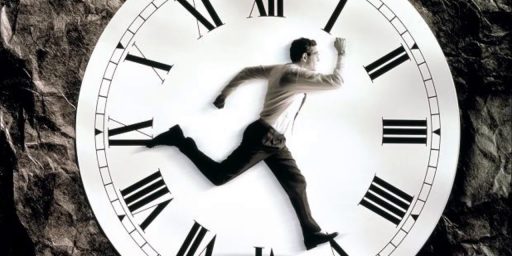The US’ Nonhierarchical Parties
Lack of control of label is lack of control, ultimately, of a party.

In the comment thread of a previous post, Matt Bernius points out the following tweet from Matt Grossman (a political scientist at Michigan State University who studies American politics):
Now, I am nowhere near as versed in the Americanist literature as is Grossman, but I will point out that from a comparative politics point of view, the weakness of US parties is not a shock.
US parties are candidate-centric and they have, ultimately, very little control over the use of their labels because the threshold to being a precandidate* (i.e., being a candidate for the nomination, and hence the usage of the party’s name on the ballot) is low. Mostly it is filling out a form and paying a modest fee. There is not a test of party loyalty or knowledge. There is no vetting by party members. There is sign on the dotted line and fork over some cash.
All of this reminds me of the discussion of US parties in my 2014 book with Matthew Shugart, Arend Lijpart, and Bernie Grofman:
Primaries affect parties internally, by making them nonhierarchical. What primaries do is to deprive parties, as organized entities, of their vital role in nominating candidates, and by extension, weaken the disciplining authority of party leaders. Furthermore, primaries require candidates in the same party to compete with each other for the voters’ support and encourage these candidates to stress their differences.
Page 187, A Different Democracy.
And:
Primaries mean that the ability of party leadership to shape a party in a particular direction in terms of philosophy or party choice is quite limited. Rather, the process is one of self-selection by candidates, who choose to adopt a party label and run in the primary, which is then validated or rejected by voters on primary day. Candidates are therefore far more free agents than in systems with more hierarchically structured parties.
Page 316
So, Donald J. Trump is able to descend the escalator and join the GOP fray in 2016. Bernie Sanders, a lifelong independent, signed up in 2016 for the Democratic contest and is back for more in 2020. Mike Bloomberg, one-time Republican mayor of NYC, has parachuted in for a shot as being the Democratic leader well.
Our parties, as institutions, are weak. There is no singular leader, or even a clearly delineable collective one, who “decides” the nomination.
And yes, to Grossman’s point, money, social media, and other factors have made it easier, it seems, for the nominee to be less what existing party elites might want. Still, the lack of control is not new. And it may be that various manipulations of the rules (such as the GOP’s increase in the significance of plurality winners and the Dem’s front-loading) have made such outcomes more likely, especially in multi-candidate contests.
One more quote from the book, because the issue of polarization has become even more significant since we wrote it:
The nonhierarchical, or bottom-up, nature of the parties means that the degree to which the parties are polarized or not is a function of the members themselves, not party elites or centrally enforced policy platforms. For example, before the partisan realignment that came about with the 1994 congressional elections, the parties were more ideologically amorphous, as noted earlier, because the result of the bottom-up nature of the parties meant that many conservative southern Democrats influenced the behavior of that party. Once those conservative southern Democrats switched to being conservative southern Republicans, this changed the nature of both parties. Such dynamics mean that factionalism within the parties can lead to changes on policy positions (bubbling from the bottom up), for example, the influence of evangelical candidates within the Republican Party in the 1980s and 1990s and, more clearly, the emergence of the Tea Party faction within the Republican Party in the 2010 election. Faction influence of this nature can be seen in the 2011 fight in the Congress over raising the federal debt limit. In that debate, Republican Party leader Speaker of the House John Boehner appeared willing to compromise with the Senate and the Obama administration on the legislation, but was initially blocked by the Tea Party caucus in the House of Representatives. The nonhierarchical nature of the party system was illustrated by the fact that Speaker Boehner had to negotiate with the Tea Party caucus and could not simply assert control over them, as is the case in more hierarchical party systems (as we typically see in European cases). The ability of Tea Party candidates to win primary elections allowed them to, from the bottom up, influence public policy outcomes.
P. 189
So, for example, if Bernie were to get the nomination, it would contribute to the further polarization of our party system and not because the DNC wanted to go in a more leftward direction, but because the primary process (a bottom-up process) did.
*”Precandidate” is a common term in Colombia, which I think actually better captures where we are in the race for the presidency at the moment. I realize that Bernie, et al., are candidates for the nomination, but none of them are candidates for office yet, hence I would love for “precandidate” to catch on in these discussions.






I love learning new things and you’ve given me new reasons to dislike primaries. I tend to latch on to things and lately my thing has been that we need more than two parties. It seems like you prefer stronger parties and I do as well, with the condition that there be more than two and that we have a system that wastes as few votes as possible.
Absent some major event in the near future, change will probably take decades but the sooner we get there the better.
It would not be great for our democracy if Bloomberg followed Trump — I think that would be a significant shift towards an oligarchy.
Also, Ross Perot’s biggest mistake was not just buying his way into one of the parties. He must have been kicking himself when he saw Trump’s rise, and if Bloomberg pulls it off, Perot will be spinning in his grave.
@Gustopher: Until we have a constitutional amendment that overturns Citizens United and Buckley v. Valeo, we might be forced to choose between rich guys. I doubt that Perot would have been accepted in the way Trump was back in the early 90s, but who knows.
I’d also be happier with more political parties. It would make it harder to turn every cleavage or difference of opinion into a binary left/right, Dem/Rep issue. But how?
@Gustopher: I have long maintained (like for multiple decades at this point) that if Perot really had wanted to be president, he should have run the in 1992 Dem primary. It was an open field and he would have had a shot. The third party route was foolish.
@gVOR08: Well, in no particular order (and not necessarily all of them):
1. Do away with primaries (for all offices)
2. Change the way we elect the president to 2-round majority or IRV
3. Change the way we elect the House (at least) to a more proportional system. I would prefer MMP but some version of RCV (aka STV) would work.
And yes I know what the odds are (but those are the answers).
Even just getting rid of primaries would likely alter the party landscape (see Canada, the UK, and India (and NZ before they shifted to MMP in the 1990s) as systems with single state majority elections, but multiple parties).
The result of our system is that our parties have little allegiance to people; a McCain, when he lived, or a Romney or even an ex-President like Bush and Obama have very little influence on their parties. Even ideas get abandoned in the drive to hold power; the balanced budget amendment folks are not heard much these days.
@Steven L. Taylor:
I wonder if primaries (and specially the presidential primaries, one state every week) were note, in practice, a kind of IRV (and in a way perhaps more easy to process by the human brain than a formal IRV).
@Miguel Madeira: In short, no it isn’t. It is a sequenced process wherein previous outcomes influence downstream participation.
Indeed, since the “I” in IRV is “Instant,” the US process is practically the opposite.
Plus, each voter only gets to vote for their top preference. In IRV you can rank all your preferences up to N candidates.
“Americanist”? What, pray tell, is that?
(I suspect that it is not what my brain immediately jumped to, namely Americanist : American :: Historiography : History…)
@DrDaveT: An Americanist is a someone who specialized in the subfield of political science focused on American (i.e., US) politics. They tend to study, exclusively, the United States.
I am a comparativist by trade (one who studies comparative politics and therefore sees the US as simply one case amongst many).
While there is overlap between the subfields (and there are other subfields of PoliSci as well), Americanists tend to be (at least from a comparative POV) a bit insular.
How does this differ in multiparty parliamentary systems?
I’m thinking of Israel, for instance, whether the top two parties seem really close other than a difference in Netanyahu. (This is an oversimplified outsider’s view)
And I think parties pop into existence and vanish at the drop of a hat in France.
I don’t see how that differs greatly from the Republican Party going from the party of George W. Bush to the Tea Party to Trump’s Party in less than twenty years.
@Gustopher: There is a lot to unpack in your comment.
I think that the easiest way I can answer quickly: much that is problematic about our politics is because voters are forced into a binary choice.
Why, for example, do so many folks on the right have to rationalize their support for Trump?
More generally, it is clearly true there are more than 2 political currents in the US. More choice is better, as is more competition.
In regards to the topic of this post, parties in most parliamentary systems have leadership that can control their members in the sense that if you are going be in Party X, there is an expectation that you will vote with the party, as the voters expected when they elected you. That is what a hierarchical party looks like. And if you don’t like it, you can form your own party (assuming there are voters out there who want what you have to offer).
I’ll throw this out although I’m struggling with it and have little by way of clear thoughts. As third parties are not viable, party evolution in the US can proceed by collapse and replacement, the last example being the Republican Party replacing the Whigs some 170 years ago, or by coalition members changing parties. The latter may be a slow process, I suspect as a physicist said of his own profession, changing one funeral at a time. are we now experiencing a reshuffling of the coalitions that will wear the old Rs and D labels, but with redefined Republican and Democratic parties?
FDR’s Democratic party was a coalition of Southern reactionaries and Northern labor. LBJ blew it up with the Civil Rights Act and subsequent Ds weakened their allegiance to labor, and allowed labor to be weakened. The parties seemed to become Republicans as the party of big business and Democrats as a motley collection of whoever didn’t fit with Republicans. But as the Southern (and rural) Ds were welcomed by Rs, they’ve drawn the party to a faux populism embracing, shall we say delicately, Southern sensibilities. Before the unlikely success of Trump there was fear (or gloating, depending on point of view) that the Republican Party was turning into a regional and rural rump party. Is that maybe still true? Are they turning into a party financed by resource extraction industries and supported by reaction against demographic and social change? Are we seeing a party realignment with the economic split between the parties becoming a cultural split?
@gVOR08:
Possibly. This not too different from how I see it.
The tricky thing about a re-alignment is that it is almost impossible to see it until it has mostly sorted itself out.
@gVOR08: In simple terms, I don’t think replacement (e.g., the Reps replacing the Whigs) is at all likely with the primary system. Because it is substantially easier to mount an internal change via primaries than it is establishing a new party.
Evangelicals became key political actors in the US not by forming a party. They did so by actively recruiting and running candidates for GOP nominations in the late 70s/early 80s.
The Tea Party had influence in the House not by forming a Tea Party, but instead by winning nomination fights.
Trump took over the GOP by winning the nomination.
I think I detect a paradox here:
On the one hand, any random idiot, as demonstrated by Trump, can get ay nomination for any elected office in any party due to the lack of a party hierarchy. On the other hand, the Representatives and Senators of each party, however they came to be nominated and elected, speak, act, and vote almost in lockstep, presumably as dictated by the leadership.
You get exceptions like McCain and Romney, but these are rare.
@Kathy: Ironically, primaries are a huge part of the problem: members of Congress have to appeal to narrow slices of primary voters, and so the support of the president becomes key. But, really, the whole the system is built on that foundation at the moment.
@Steven L. Taylor:
I need to give this some more thought. It would seem, however, the hierarchy is formed at the bottom rather than the top, and that it changes from time to time.
@Steven L. Taylor:
Should Bloomberg actually win*, we would finally get the natural experiment that would tell us whether this is a structural property of our party system, or a contingent fact about having a strongly populist base. Personally, I would not expect Congressional Democrats to fall in with whatever right-of-center (and racist, and sexist) policies Bloomberg put forward, precisely because I don’t think their local support is tied to Bloomberg’s base (if any) in anything like the way GOP candidates have to make the Trumpists happy in order to stay in power.
*No, I am not saying this is likely. No, I am not saying it would be a good thing. Really. It’s a thought experiment.